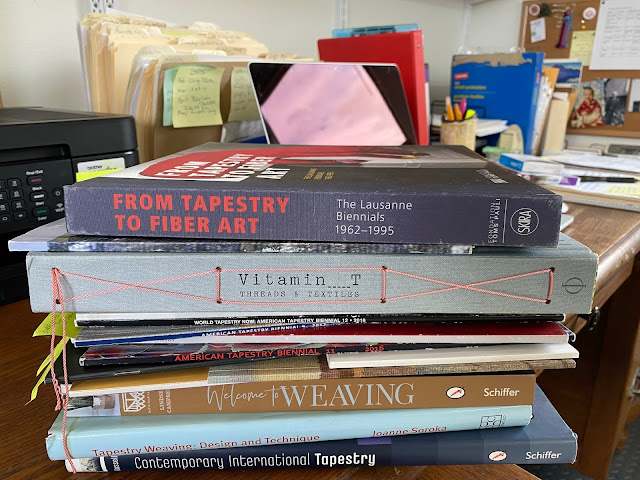These are some of the books I've been poring over lately. It's been a fascinating dive into recent tapestry and fiber art history. It's a wild and woolly world out there! I've had a lot of fun looking at and sorting through dozens of the best contemporary tapestries and fiber works, figuring out how to talk about all the diversity in an organized way.
This Saturday, March 13 at 10:00 a.m. Central Time, I will be with the Weavers Guild of Minnesota sharing a lecture about Tapestry Design Elements and Principles. That might sound dry and academic, and it is possible I'm a bit of a design nerd. But I strongly believe that familiarity with some basic terms and concepts that are used to talk about how artworks are put together can be super useful for tapestry weavers. For me, it's not about throwing around art jargon, it's about knowing how to identify and figure out how the parts of a tapestry are working together. For me these concepts are helpful in talking about tapestry, interpreting it, evaluating it . . . and diagnosing what might not be working in my own work. In the talk this weekend, I've narrowed down the usual long list of Elements of Art and Principles of Design to the eight that I think are especially important for tapestry weavers. We look at each element and principle in terms of how it works in lots of actual tapestries.
Go HERE to register for this Saturday's talk about Tapestry Design Elements and Principles. The tickets are on a sliding scale starting at $10, and the lecture will be recorded and available for two weeks to those who register.
Next weekend, on Saturday, March 20 at 1:00 p.m. Eastern, I'll be presenting a lecture for the Florida Tropical Weavers Guild virtual conference about a particular trend in contemporary tapestry, toward work with lots of texture, relief elements, mixed media and even 3-D work. This topic is of great interest to me lately and raises interesting questions about what tapestry is and isn't today. HERE is where you can find out more about this talk. You can head HERE to become a member of the guild and register for the conference. I'll be presenting this same lecture for the Weavers Guild of Minnesota on May 1, and you can register HERE for that date.
It hasn't all been book-work lately. . . I'm about halfway through weaving the piece on my floor loom with the working title SkyGrass.



2 comments:
Nice post, Molly! I'm curious about those top two books; I haven't seen either of them. Off to look them up...
The top one is a great overview of the shift from tapestry to off-the-wall fiber art that began to happen in the 50s and 60s. Vitamin T is a look at contemporary, cutting edge fiber art through the lens of contemporary art, not tapestry per se. I recommend both!
Post a Comment